#Data mining in India
Text
Data curation and Data Mining company
We, at Oriental Solutions, the best data curation and data mining company in Chennai, India are primarily engaged in offering health care and medical transcription services to other companies. Apart from that, we also work for automotive and consumer goods / services verticals.
Oriental Solutions is a leading company based in Chennai, India specializing in comprehensive data solutions. With expertise in data curation, mining, and migration, we provide efficient document management and image curation services. Our skilled team excels in medical transcription, secretary services, billing, and coding, ensuring accurate and reliable outcomes. Trust Oriental Solutions for top-quality data summarization and a wide range of medical-related services. Experience excellence and professionalism with us .
#Data curation and Data mining company in India#Data mining and Data curation#data mining#data curation#data mining company#data curation#data mining in UK#Data mining in US#Data mining in India#Data curation in India#Data curation in us#Data curation in UK
0 notes
Text
Enhancing Safety in the Mining Industry: The Role of Advanced Telematics Solutions

The mining industry faces significant challenges in ensuring the safety of its workforce amidst hazardous working conditions and complex operational environments. Despite stringent safety regulations and protocols, accidents and incidents continue to pose risks to personnel and assets. In this context, the adoption of advanced telematics solutions emerges as a critical strategy to enhance safety standards and mitigate risks within mining operations.
In this article, we will discuss the role of telematics technology, its key features, applications, and benefits in the mining industry.
Understanding the Role of Telematics Technology in the Mining Industry
Telematics systems employ a combination of hardware and software components to collect, transmit, and analyse data from vehicles and assets in real-time. The GPS tracking devices installed in vehicles capture location coordinates, speed, and route information, which is transmitted to a centralised platform via cellular or satellite networks. In addition, onboard sensors and diagnostics systems monitor vehicle performance metrics such as engine health, fuel consumption, and maintenance status.
This data is then processed and analysed using advanced algorithms and fleet telematic analytics tools to generate actionable insights and performance reports for fleet managers and stakeholders. By providing visibility into key operational parameters and safety metrics, mining telematics systems enable mining companies to proactively identify risks, implement preventive measures, and optimise resource allocation to enhance safety and efficiency across their operations.
Key Features of Telematics Fleet Management System for Mining Operations
Live Location Tracking: Track the real-time location of vehicles and equipment, enabling better fleet management and resource allocation.
Rash Driving Alerts: Receive alerts for instances of aggressive or unsafe driving behaviour, allowing for immediate intervention and corrective action.
Accident Detection: Detect accidents or collisions as they occur, enabling rapid response and assistance to affected personnel.
Autonomous Emergency Braking (AEB): Automatically apply brakes in emergency situations to prevent or mitigate collisions, enhancing overall safety on the road.
Tailgating Detection: Identify instances of tailgating, a common cause of accidents, and alert drivers to maintain safe following distances.
Overspeeding Monitoring: Monitor vehicle speed in real-time and receive alerts for instances of speeding, helping to prevent accidents and ensure compliance with safety regulations.
Drowsiness Detection: Detects signs of driver drowsiness or fatigue and provides timely alerts to prevent accidents caused by impaired alertness.
Distraction Monitoring: Monitor driver attentiveness and detect distractions such as mobile phone usage or inattentiveness, reducing the risk of accidents due to driver distraction.
Application of Telematics in the Mining Industry
Enhanced Driving Behavior Insights
Gain comprehensive insights into driving behaviour, empowering mining companies to identify and address unsafe practices effectively. By analysing factors such as speed, acceleration, and braking, organisations can develop targeted strategies to promote safer driving habits among their workforce.
Access to Incident Videos
Access to incident videos in real-time facilitates prompt response and investigation of accidents or incidents within mining operations. This capability enhances safety protocols by enabling timely review and analysis, ultimately contributing to the development of more robust risk management strategies.
Fleet Performance Optimization
Utilise data analytics to optimise fleet performance and efficiency in mining operations. By leveraging insights derived from telemetric fleet management systems, organisations can identify areas of inefficiency and implement corrective measures to reduce operational costs and enhance productivity across their fleet.
Benefits of Using Telematics in Mining Operations
Telematics technology finds various benefits in mining operations, contributing to enhanced safety, efficiency, and productivity. Some key benefits include:
Fleet Management: Telematics systems enable real-time vehicle tracking and equipment, allowing managers to monitor their location, speed, and status. This ensures efficient fleet management, optimal asset utilisation, and timely maintenance scheduling.
Remote Monitoring: Telematics enables remote monitoring of equipment performance and health, including engine diagnostics, fuel consumption, and maintenance alerts. This proactive approach helps prevent unexpected breakdowns, reduces downtime, and extends equipment lifespan.
Safety Enhancement: Integration with fatigue monitoring systems helps identify signs of driver fatigue, allowing for timely intervention to prevent accidents caused by drowsiness.
Data-Driven Decision-Making: Historical performance data and trend analysis provide valuable insights for long-term planning and strategic decision-making, driving continuous improvement initiatives.
Scalability: Telematics solutions are scalable and customizable to meet the evolving needs of mining operations, accommodating changes in fleet size, geographic expansion, and technological advancements.
Conclusion
To sum up, investing in mining telematics solutions is important for safeguarding worker wellbeing and enhancing operational efficiency in the mining industry. By leveraging telematics technology, mining companies can proactively identify and mitigate safety risks, optimise fleet performance, and ensure regulatory compliance.
#telematics in mining#telematics#mining telematics#applications of telematics#advantages of telematics#telematics solution providers in india#telematics vehicle tracking#truck fleet telematic#mining vehicle telematics#commercial fleet telematics#telematics software providers#telematics solutions#telematics data#telematics system#fleet telematics analytics#vehicle telematics data#mining telematics solution
0 notes
Text
Compensation Survey & Analysis for an Effective Compensation Strategy

The market is competitive in many aspects and one of the crucial aspects for any organization is to have and retain good talent. The market is dynamic and on continuous change due to rapid transformation in technology, hence affecting businesses. Retaining good talents has become crucial as their major resource for any company. To deeply strategize retention plans, organizations can easily opt to outsource data mining services for compensation surveys and analysis reports.
Uniquesdata offers high-quality data mining services from a team of experts to ensure the quality and reliability of the project.
#data mining services#data mining services india#outsource data mining services#data mining service providers#data extraction services#data entry services#web data extraction services#outsource data extraction services
0 notes
Text
Web Research Services in india
0 notes
Text
Achieve agility with our free web crawling services
Outsource Bigdata uses a variety of web crawling tools and techniques to help startups crawl the web easily. We also help you navigate your digital journey with the most effective web crawling services at an affordable cost. This is done by delivering your data in the required format, accessible to employees and applications.
For more details visit: https://outsourcebigdata.com/data-automation/web-scraping-services/web-crawling-services/
About AIMLEAP
Outsource Bigdata is a division of Aimleap. AIMLEAP is an ISO 9001:2015 and ISO/IEC 27001:2013 certified global technology consulting and service provider offering AI-augmented Data Solutions, Data Engineering, Automation, IT Services, and Digital Marketing Services. AIMLEAP has been recognized as a ‘Great Place to Work®’.
With a special focus on AI and automation, we built quite a few AI & ML solutions, AI-driven web scraping solutions, AI-data Labeling, AI-Data-Hub, and Self-serving BI solutions. We started in 2012 and successfully delivered projects in IT & digital transformation, automation-driven data solutions, on-demand data, and digital marketing for more than 750 fast-growing companies in the USA, Europe, New Zealand, Australia, Canada; and more.
An ISO 9001:2015 and ISO/IEC 27001:2013 certified
Served 750+ customers
11+ Years of industry experience
98% client retention
Great Place to Work® certified
Global delivery centers in the USA, Canada, India & Australia
Our Data Solutions
APISCRAPY: AI driven web scraping & workflow automation platform
APYSCRAPY is an AI driven web scraping and automation platform that converts any web data into ready-to-use data. The platform is capable to extract data from websites, process data, automate workflows, classify data and integrate ready to consume data into database or deliver data in any desired format.
AI-Labeler: AI augmented annotation & labeling solution
AI-Labeler is an AI augmented data annotation platform that combines the power of artificial intelligence with in-person involvement to label, annotate and classify data, and allowing faster development of robust and accurate models.
AI-Data-Hub: On-demand data for building AI products & services
On-demand AI data hub for curated data, pre-annotated data, pre-classified data, and allowing enterprises to obtain easily and efficiently, and exploit high-quality data for training and developing AI models.
PRICESCRAPY: AI enabled real-time pricing solution
An AI and automation driven price solution that provides real time price monitoring, pricing analytics, and dynamic pricing for companies across the world.
APIKART: AI driven data API solution hub
APIKART is a data API hub that allows businesses and developers to access and integrate large volume of data from various sources through APIs. It is a data solution hub for accessing data through APIs, allowing companies to leverage data, and integrate APIs into their systems and applications.
Locations:
USA: 1-30235 14656
Canada: +1 4378 370 063
India: +91 810 527 1615
Australia: +61 402 576 615
Email: [email protected]
0 notes
Text
#Mining Shovel Market Current Scenario and Industry Growth Forecast with Major Key Players data by 2032#The global mining shovel market is estimated to create an absolute dollar opportunity of over US$ 10 Bn by the end of 2032. The sales of mi#exhibiting growth at 2% to 3% CAGR during the forecast period 2022-2032. Increasing emphasis on the development and introduction of advance#Mining shovels are mostly electric powered#and are primarily utilized for digging and loading earth#and for the extraction of minerals. Mining shovels are utilized in the surface mining of gold#copper#coal#and other commodities across the globe. Mining shovels are available in a wide range of payload capacities all over the world. They are des#Due to the rapid industrialization of emerging economies#particularly China and India#there has been significant growth in the demand for mined resources such as coal#iron ore#etc. Thus#it is anticipated that the demand for mining shovels will increase in the near future.#To Know more@#https://www.futuremarketinsights.com/reports/mining-shovel-market
0 notes
Text
Countries that have data I could find:
1. Malaysia: 23
2. India: 22.9
3. Singapore: 22.8
4. China: 22.1
5. Thailand: 20.5
6. Hong Kong: 20.2
7. Vietnam: 19.7
8. Nigeria: 19.7
9. Japan: 19.4
10. Spain: 19.2
11. Indonesia: 19.1
12. Poland: 19
13. Italy: 18.9
14. Taiwan: 18.9
15. Russia: 18.7
16. Mexico: 18.7
17. South Africa: 18.7
18. France: 18.5
19. United Kingdom: 18.3
20. Switzerland: 18.2
21. Canada: 18.1
22. Netherlands: 18.1
23. Greece: 18.1
24. United States: 18
25. Australia: 17.9
26. Turkey: 17.8
27. New Zealand: 17.8
28. Slovakia: 17.8
29. Germany: 17.6
30. Brazil: 17.4
31. Ireland: 17.3
32. Croatia: 17.3
33. Austria: 17.3
34. Czech Republic: 17.2
35. Chile: 17.2
36. Belgium: 17.2
37. Portugal: 16.9
38. Bulgaria: 16.9
39. Israel: 16.7
40. Finland: 16.5
41. Norway: 16.5
42. Sweden: 16.2
43. Denmark: 16.1
44. Iceland: 15.6
pls reblog for data size
185 notes
·
View notes
Text
Keepers of the Quaich
This time, we're going to look at things a bit differently and this could very well be my most speculative post ever. So be it: it is a risk I am taking and warning you about from the get go.
The only thing Mordor understood about the next October 4 event organized by the US Chapter of The Keepers of the Quaich is something that probably gave them collective relief: S is not going to be with C on her birthday. Not together. Not on the same continent. Shut up, shippers, you are stupid.
As usually, Mordor takes things at a very primitive face value, without bothering for context. But they always focused on the lewd side of the story, not on its deep ramifications, of which there are many. Anything that denies S's halfwit manwhore image upsets them greatly.
The Scottish society of The Keepers of the Quaich is not one of those old, steeped in tradition clubs, but it is damn selective. It only dates back to 1988, which is almost five minutes ago, for Europe (and especially the UK) and is deeply rooted in Highlands' lore, celebrating excellence in whisky trade and promotion worldwide. General facts about it have already been discussed elsewhere, but with a bias and little to no context. Also, really LOL at Mordor's idiocy to think that was a fan promotion event and go ballistic for the members-only and by invitation access to it.
Membership is by co-opting and with a five-year proven performance history only (ten years, if you step up to Master level). You need not one, but two recommendations, which makes it harder to join than a Masonic lodge or the Rotary Club (and I know what I am saying, heh). That S could actively seek to be inducted, rather sooner than later, is pretty much clear, as he could use the network it readily provides, along with the prestige:
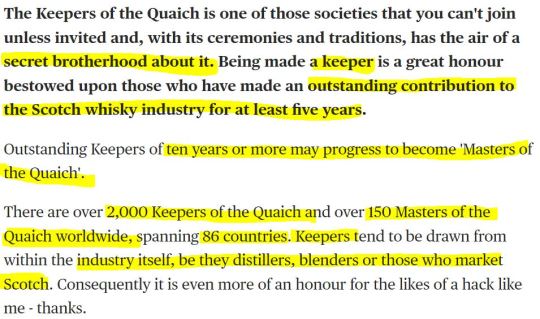
(Sourced at: https://www.diffordsguide.com/encyclopedia/341/people/keepers-of-the-quaich)
I first had a look at the list of its International Chapters and it is interesting to notice Muslim countries as Turkey or the Emirates each having their own chapter, which clearly tells me it's all about luxury and more specifically, luxury hospitality business, in that case. If inducted after the customary five years' wait, S could also make good use of the German chapter's (a market that proved to be very problematic for him) network, along with the Nordics and Netherlands, if he would think about cleverly expanding his trade in the EU. Last but not least, I would keep an eye on Brazil and India (along with the more predictable South Africa and Australia), because he already has a solid fanbase in the first one and well, Asia is always interesting, when it comes to alcohol business.
I did not really bother with the list of the Patrons, which spells a good and prestigious sliver of Debrett's Peerage's Scottish section. But I also looked at the list of the Management Committee, who does all the hands-on dealings and is directly responsible for the induction ceremony of new members. Aside from representatives of Diageo and Pernod Ricard (giants of the alcohol business world), a familiar name popped right at the bottom of the page:

Annabel Meikle, Director of The Keepers of the Quaich and as such, directly involved in the management of its activities (and probably also in all the underground shenanigans leading to the induction of new members, too). A great contact to have in your rolodex, judging by her public CV on LinkedIn:

Glenmorangie (also a member of the Keepers) - keep that reference under your sleeve, we are going to need it soon :).
Could she be related to...

I am leaving this without an answer, because I don't know and I will always refuse to go data mining for anything, but that sure as hell is not a common surname, as Smith or Martin!
At any rate, Mrs. Meikle is also (along with the Duke of Argyll, the current Keepers Grand Master) a member of The Scottish Committee of something very, very prestigious: The Worshipful Company of Distillers (https://www.distillers.org.uk/), based in London and founded in 1638, by Royal Charter (for “Body Politique and corporate” to govern the “Trade Arte and Mystery of Distillers of London” - how I love history, people!) granted by Charles I, a Stuart (of course). I am speculating and having visions of Livery status and Freedom of the City, followed by Knighthood for S (no bong needed, this particular narrative writes itself and believe it or not, it's not entirely without logic). And it is my strict constitutional right to be a poetic coo about it - that guy is smarter than we thought and I would curate that contact to death if I were him (but I am not, I am just a benevolent and intrigued observer, as you all know). Back to Earth from these optimistic conjectures, I will keep a tab on it, as I dutifully took note that one of their current interests is tequila:

Onwards to the US. We can have a fair idea of October 4th event just by looking at one of their few press releases on the occasion of the Chapter's launch gala, on September 25 2019, in New York (https://www.distilledspirits.org/wp-content/uploads/2019/10/KOTQUSA-Release-10.04.19.pdf - with quotes selected by me):
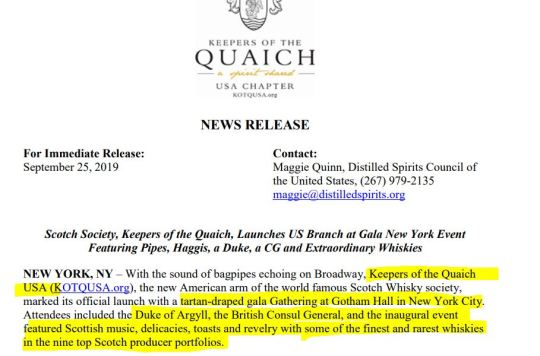


Moët Hennessy. Another reference to keep under our sleeve, for it will be soon very relevant. So yes, what has been speculated by Miss Marple is partially true: more business than aristocratic. But this is only if we do not consider as American aristocratic the venue of the next event. The Metropolitan Club is a very East Coast, WASP old money and (well, technically yes) Republican (but not MAGA Republican and this, to me, is very important for some reason) organization:
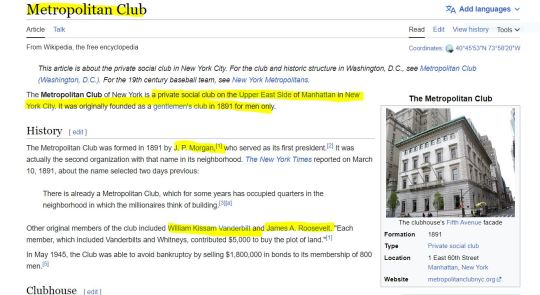
That was the state of play on Friday, folks, and I was already excited to share my optimistic findings with you. And then, C went to Paris and more dots started to speculatively connect. Bare with me for this long passegiata, I think it's worth it.
It was particularly important that C would be seen in a very friendly-casual pose with Delphine Arnault, out of all the other people attending that event. Not because Arnault is currently the big boss of Dior and Loewe (as I already explained here: https://www.tumblr.com/sgiandubh/729801825900953600/city-of-lights?source=share). And not only because C suddenly seems very interested to renew and expand her fashion days' old network. But also, because, as I already said, Delphine Arnault is also the daughter of her father and in France, business and family are always closely entwined. Always.
The French luxury market is roughly split between two behemoth players: Bernard Arnault (LVMH Moët Hennessy • Louis Vuitton S.A) and Antoine Pinault (Kering, ex- Pinault-Printemps- Redoute). These people and their businesses are number 1 and 2, respectively, on the global market. And out of these two, the only one very interested in the alcohol business is Arnault (Pinault does not deal in this sector).
So I took a look at his very diverse alcohol and spirits brand portfolio (25 references - https://www.lvmh.com/houses/wines-spirits/): rhum, brandy, champagne, tequila, wines (Argentina and even China). Two Scottish whisky brands: first Ardberg (the graceful peat from Islay). And - oh, hello, Mrs. Meikle - Glenmorangie, acquired by Arnault in 2004, after a bitter battle with Pernod Ricard (https://www.nytimes.com/2004/10/21/business/world-business-briefing-europe-france-scotch-maker-acquired.html):
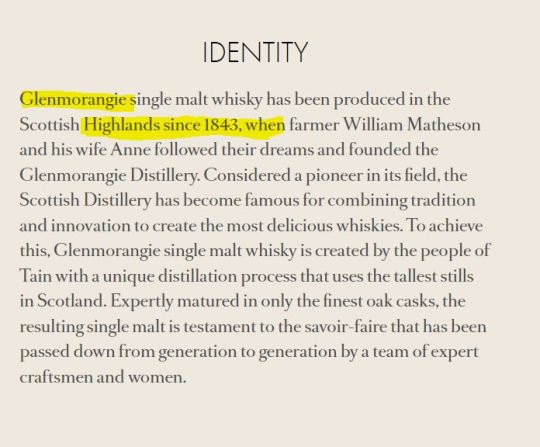
Back at Mrs. Meikle's CV - hers was a pivotal role in the post-acquisition reshuffle, as part of LVMH:

Coincidence? I think not.
And then also a bourbon reference. Woodinville (based in the state of Washington, USA) with a pitch that made me grin again like the Cheshire Cat:

Sounds familiar? Rings a bell? See a pattern? You should: no, it's not S in disguise, but it could be SS in a couple of years, if S decided to sell it for a hefty profit.
But I was also interested in what is missing from this catalogue.
NO GIN.
Who knows? Maybe these French people could be enticed? In that case (and remember: I am SPECULATING), it would have to be a brand with a proven track record. You see, Arnault is famous for always buying only brands with a proven history and proven recognition (Tasting Alliance, anyone? LOL). Up until now and as is, FMN is just a pet project and a virtual endeavor. Nothing more and we shall see. But that little wild Scottish gin which could win hearts and already an award in Frisco is something completely different.
Now, then. You connect the dots. You draw your own conclusions. I see something very intriguing here and, as I already told you, the business underground situation is completely different from the bland façade.
You see, this is not about papers or checking a pulse or awkwardly grabbing a fist on some stairs. This is show me the money time. This is all about finding unexpected connections, at a very high level and on a very narrow niche.
So you think S and C can't stand each other anymore?
Humbug. They have each other's back from Day 1. And more. Ship on, ladies. Whatever clownery these days might bring, I know what I know. And by now, you should start asking yourselves the real questions, not if Waldo is with Carmen Sandiego (we KNOW), nor if they were online at the same time or not. I mean, that's cute: but to be honest, I think we're past that... uh... waypoint?
Next on my list is that Lallybroch trademark thing. This is the most complex one and I will take my time. I may speculate, but never without a logical base. And I always take these things very seriously.
Keepers of the Quaich, indeed. :)
247 notes
·
View notes
Text
The Hound of the Baskervilles: Three Broken Threads
Hat tip to @myemuisemo for another excellent post that covers much of what I was planning together:
Data protection was not really a thing back in 1889. However, paper hotel registers would be something filled in by the front desk staff, not the guest. They would contain details of extra charges incurred as well, all stuff generally done by computer, but you can still buy paper copies today. Particularly for the Indian market, where less than half the population have Internet access. These registers are generally mandatory and in some countries, the data will still be passed to the police when it concerns newly arrived foreigners. That's why they ask for your passport.
Newcastle upon Tyne, the one people generally talk about as opposed to Newcastle-under-Lyme in Staffordshire, was at the centre of a major coal mining area in North-East England, the Durham and Northumberland coalfields being in close proximity. The industry was still employing children - boys as young as 12 could work in mines - and was still a pretty dangerous, not to mention unhealthy industry.
The British economy was heavily reliant on coal, especially the newly built electric power stations. While the railways had a big coal trade for internal transport for domestic purposes, boats also played a big role, either going via canal or down the East Coast of Great Britain to the London Docks. This route would become vulnerable to German attack in the World Wars, particularly in the second war from fast torpedo boats known to the British as "E-boats"; the East Coast convoys are a lesser-known part of the naval war, with Patrick Troughton having served with Coastal Force Command.
The Mayor of Gloucester, like most civic mayors in England, is the chair of the council, elected to a one-year term by their fellow councillors. The current holder is Conservative councillor Lorraine Campbell. It's a mostly ceremonial role involving going to various events while wearing a red cloak and a big hat:
Gloucester's Deputy Mayor is called the Sheriff of Gloucester. There is still a Sheriff of Nottingham, by the way.
The Anglophone Canadian accent was historically noticeably different to an American one and of course had its own varieties. They've gotten closer over the decades, especially due to television.
Sir Henry would have limited luggage space on the ship over, so three pairs of boots would be reasonable. He'd have to ship over anything else at further cost, so it could be cheaper to buy new in London.
Deliveries of telegrams that weren't in the immediate area of the office cost extra. Bradshaw's Guide for Tourists in Great Britain and Ireland would state the nearest telegraph office for a town, as the 1866 edition demonstrates:
Sir Charles' estate was worth around £80m in today's money, but that would not even get him onto The Sunday Times Rich List, which starts at £350m (Sir Lewis Hamilton, i.e. the F1 driver). It tops out with Gopichand Hinduja and his family at an estimated £37.2 billion, whose conglomerate is many focussed on India, but also are the biggest shareholders in US chemical company Quaker Houghton.
Westmoreland was a historical county in Northern England; it was absorbed into Cumbria in 1974, but its area became part of the Westmoreland and Furness unitary authority in 2023.
"Entailed" means that Sir Charles has stipulated in a legal document that the Baskerville estate would have to pass to Sir Henry's heir intact. This was a feudal era practice that has now been abolished in most jurisdictions, with limited remaining use in England and Wales. Simply put Sir Henry is not allowed to sell the house or the land, even part of it. He can do what he likes with the cash and probably the chattels, the movable property like the candlesticks and the toasting forks.
This page covers it in relation to the works of Jane Austen with relevant spoilers:
Borough is another name for the area of Southwark. It got a Tube station in 1890, when the City and South London Railway opened, now the Bank branch of the Northern line. It also is famous for Borough Market, then a wholesale food market under cover of buildings from the 1850s. Today it is a retail market for specialty food; kind of like a farmers' market.
In 1888, the 10:30 from Paddington would get to Exeter at 15:35, a journey of five hours. @myemuisemo provides route maps. I would add at this point, GWR services to SW England went via Bristol, adding a lot of time to the journey, while the LSWR route from Waterloo was a lot more direct. Wags dubbed the former "the Great Way Round". The construction of two cut-off lines allowed the GWR to go via Westbury and Castle Cary.
I will cover the modern day condition of the route in my Chapter 6 post.
The GWR still had some broad-gauge track at 2,140 mm(7 ft 1⁄4 in) left that Brunel had favoured, but this would be finally eliminated in 1892.
Finally, Holmes is referencing the sport of fencing when he learns the cabbie has been given his name. The foil is the lightest of the three swords used in competitive fencing, such as the Olympics.
In an age before electronic fencing equipment, point scoring relied on the eyesight of the umpire... and the honesty of the competitions.
I was in my fencing club at university. I can't say I was that great. I preferred the epee, which doesn't have the priority rules...
12 notes
·
View notes
Text
Thousands of law enforcement officials and people applying to be police officers in India have had their personal information leaked online—including fingerprints, facial scan images, signatures, and details of tattoos and scars on their bodies. If that wasn’t alarming enough, at around the same time, cybercriminals have started to advertise the sale of similar biometric police data from India on messaging app Telegram.
Last month, security researcher Jeremiah Fowler spotted the sensitive files on an exposed web server linked to ThoughtGreen Technologies, an IT development and outsourcing firm with offices in India, Australia, and the US. Within a total of almost 500 gigabytes of data spanning 1.6 million documents, dated from 2021 until when Fowler discovered them in early April, was a mine of sensitive personal information about teachers, railway workers, and law enforcement officials. Birth certificates, diplomas, education certificates, and job applications were all included.
Fowler, who shared his findings exclusively with WIRED, says within the heaps of information, the most concerning were those that appeared to be verification documents linked to Indian law enforcement or military personnel. While the misconfigured server has now been closed off, the incident highlights the risks of companies collecting and storing biometric data, such as fingerprints and facial images, and how they could be misused if the data is accidentally leaked.
“You can change your name, you can change your bank information, but you can't change your actual biometrics,” Fowler says. The researcher, who also published the findings on behalf of Website Planet, says this kind of data could be used by cybercriminals or fraudsters to target people in the future, a risk that’s increased for sensitive law enforcement positions.
Within the database Fowler examined were several mobile applications and installation files. One was titled “facial software installation,” and a separate folder contained 8 GB of facial data. Photographs of people’s faces included computer-generated rectangles that are often used for measuring the distance between points of the face in face recognition systems.
There were 284,535 documents labeled as Physical Efficiency Tests that related to police staff, Fowler says. Other files included job application forms for law enforcement officials, profile photos, and identification documents with details such as “mole at nose” and “cut on chin.” At least one image shows a person holding a document with a corresponding photo of them included on it. “The first thing I saw was thousands and thousands of fingerprints,” Fowler says.
Prateek Waghre, executive director of Indian digital rights organization Internet Freedom Foundation, says there is “vast” biometric data collection happening across India, but there are added security risks for people involved in law enforcement. “A lot of times, the verification that government employees or officers use also relies on biometric systems,” Waghre says. “If you have that potentially compromised, you are in a position for someone to be able to misuse and then gain access to information that they shouldn’t.”
It appears that some biometric information about law enforcement officials may already be shared online. Fowler says after the exposed database was closed down he also discovered a Telegram channel, containing a few hundred members, which was claiming to sell Indian police data, including of specific individuals. “The structure, the screenshots, and a couple of the folder names matched what I saw,” says Fowler, who for ethical reasons did not purchase the data being sold by the criminals so could not fully verify it was exactly the same data.
“We take data security very seriously, have taken immediate steps to secure the exposed data,” a member of ThoughtGreen Technologies wrote in an email to WIRED. “Due to the sensitivity of data, we cannot comment on specifics in an email. However, we can assure you that we are investigating this matter thoroughly to ensure such an incident does not occur again.”
In follow-up messages, the staff member said the company had “raised a complaint” with law enforcement in India about the incident, but did not specify which organization they had contacted. When shown a screenshot of the Telegram post claiming to sell Indian police biometric data, the ThoughtGreen Technologies staff member said it is “not our data.” Telegram did not respond to a request for comment.
Shivangi Narayan, an independent researcher in India, says the country’s data protection law needs to be made more robust, and companies and organizations need to take greater care with how they handle people’s data. “A lot of data is collected in India, but nobody's really bothered about how to store it properly,” Narayan says. Data breaches are happening so regularly that people have “lost that surprise shock factor,” Narayan says. In early May, one cybersecurity company said it had seen a face-recognition data breach connected to one Indian police force, including police and suspect information.
The issues are wider, though. As governments, companies, and other organizations around the world increasingly rely on collecting people’s biometric data for proving their identity or as part of surveillance technologies, there’s an increased risk of the information leaking online and being abused. In Australia, for instance, a recent face recognition leak impacting up to a million people led to a person being charged with blackmail.
“So many other countries are looking at biometric verification for identities, and all of that information has to be stored somewhere,” Fowler says. “If you farm it out to a third-party company, or a private company, you lose control of that data. When a data breach happens, you’re in deep shit, for lack of a better term.”
9 notes
·
View notes
Text
Traditional scholarship in the history of science associates the quantifiable, universal human body with the European Enlightenment or ‘new science’. This measurable, universal body, it is argued, came to define modern medicine. Behind it lay the driving forces of political economy, [...] life insurance, and modern industrial [profit] [...]. But this widely accepted history of the universalisation and systemisation of human corporeality [...] [involves] an earlier global history of enslaving and measuring bodies in the Indies, born of the Iberian slave trade between Africa and colonial Iberian America. It was in the violent and profitable world of this slave trade that universal concepts and calculations of health risks, disease and bodily characteristics [...] emerged. Indeed, the scale of data production about bodies in the early modern world of Iberian slave trading far outpaced all contemporary systems of production of knowledge about the human body.
The key concept in this early modern quantification of the body was the pieza de Indias (Spanish) or peça da India (Portuguese). [...]
The appearance of this new measure and epistemology was intimately linked to the unprecedented rise in the size and complexity of the transatlantic commerce in human bodies during the first decades of the 17th century. The new, universal measure of man was the result of the slave trade’s need to quantify the risks of investing in human corporeality and its modern afflictions. By the late 16th century, Iberian slave traders, governments, corporations and financiers from around Europe (particularly from Genoa, Florence and the Netherlands) were already thinking of the transportation of slave bodies as units of risk.
---
The original licences for slaves transacted in Iberia were contractual concepts that did not refer to bodily characteristics [...] [and] were of limited help [...] for calculating the productivity [of a slave's body] [...]. Consequently, slave traders and slave-trading organisations, including the House of Trade (Casa de Contratación) in Seville, developed methodologies that allowed them to translate slave bodies into numbers and calculate the inherent value [...] as it related to an increasingly normalised, constant unit called the pieza. The concept of the pieza (the piece) allowed for the creation of contracts where investors, providers and the state could prospectively calculate tariff, gains and risk using quantifiable notions of bodies [...].
The historical record makes clear that the concept of ‘the piece of the Indies’ itself was already firmly established across the Atlantic basin by the early 1600s. [...] In addition to peça, Portuguese slave traders [in West Africa] used several other terms to refer to slaves who were not adult [...], reflecting an increasingly rich taxonomy [...]. Muleque or muleca [...]. Slave traders began using these terms to refer to young bodies that they discounted at rates [...]. Calculating the value of cañengues, muleques and mulecas by converting them into standard adult [...] piezas was a common practice [...]. Portuguese officials in Sao Paulo da Assumpcao de Loanda deployed the concept when they tallied ‘the dispatch’, or fees due to the Portuguese crown, for the embarkment of African slaves bound for the Americas. Such methods to appraise slave bodies became normative in Spanish America for determining the tariffs that traders had to pay to introduce slaves in the New World.
By the late 1530s, crown officials were counting the ‘pieces of slaves’ (piezas de esclavos) disembarking in Santo Domingo and selling them to miners [...] [and] hacienda owners [...] to work in the mines and estates of the island. [...] [A] concept of an ideal body for transportation and labour [...] had emerged across the Atlantic, and during the first decades of the 17th century it was disseminated across the Pacific and Indian Oceans, being widely used in Dutch trading records. [...] [S]lave traders and government officials used the term pieza to talk about other captive bodies from the Indies, most notably native or 'Indian' bodies in the Caribbean.
---
The concept of the piece of the Indies appears in full form in the 1660s as part of negotiations of the terms of the asiento de negros or slave monopoly between the Spanish crown and the Genoese financiers Domingo Grillo and Ambrosio Lomelín. The contract with the Grillos established that they would ‘bring 24,500 blacks, piezas de Indias, over the course of seven years and starting in 1662’. The monopoly established as one of its conditions that ‘the said quantity of blacks should be piezas de Indias, each one seven cuartas of height and up’. [...] Slave traders used height as a proxy for life histories of health and nutrition and as a predictor of the slave’s potential productivity [...] [and] created a complex system around the marker of height [...].
[H]aving grey hair, for instance, translated into a reduction in value of one cuarta or one-seventh of the standard pieza. The conditions of 'cloud in one eye [cataracts]' signified a reduction of two cuartas; scurvy, two cuartas; phlegm, one and one-half cuartas; a 'benign hernia', one cuarta [...]. Being older than 35 years merited a one-cuarta deduction [...]. The presence of lobanillos (small tumours) was worth one and one-half cuartas’ reduction; small fingers, one-half cuarta; incapacitating scars (burns), one and one-half cuarta; [...] localised ulcers, one-sixth of a cuarta; generalised ulcers, one cuarta; [...] short-sightednesss, two cuartas; [...] missing molars, one cuarta [...].
---
The contractual articulation of the concept of the piece of the Indies [...] formalised slave-based knowledge production about human bodies. The contract assembled a vast storehouse of knowledge, much of it held in the House of Trade in Seville, obtained from thousands of records of bodily characteristics and diseases for hundreds of thousands of bodies [...]. The Grillos’ contract set a precedent for the 1679 contract between Spanish and Portuguese merchants and the Dutch West India Company. The 1696 asiento between Spanish crown and [financier F.M.] and [financier N/P.], for example, agreed they would transport 10,000 tonnes of freight including 30,000 piezas de Indias of the ‘regular measure of seven cuartas’. Similarly, a 1709 contract between the French Compagnie de Guinée and Dutch slave traders, settled in Amsterdam, specified that the French would pay 110 pièces de huit (pieces of eight) ‘for each black piece of Indies’ delivered in the Caribbean.
As the ‘new science’ of the European Enlightenment dawned in Europe, the piece of the Indies was well established as the most disseminated universal measure of the human body.
---
All text above by: Pablo F. Gomez. "Pieza de Indias: Slave Trade and the Quantification of Human Bodies". A chapter in New World Objects of Knowledge: A Cabinet of Curiosities (edited by Mark Thurner and Juan Pimentel), pp. 47-50. Published 2021. [Bold emphasis and some paragraph breaks/contractions added by me. Presented here for commentary, teaching, criticism purposes.]
#abolition#caribbean#tidalectics#pathologization#intimacies of four continents#archipelagic thinking#indigenous#carceral geography#geographic imaginaries
15 notes
·
View notes
Text
Visit the Oriental Solutions blog page to explore a dynamic company dedicated to providing end-to-end solutions for information processing and document management needs
#data curation#document management company in india#document management company#document management services in india#oriental solutions blogs#E-publishing company in India#Data mining company in Chennai India
0 notes
Text
two positions on effective nuclear power advocacy
1. everytime there's an attempt to build a nuclear plant in india there are mass local protests which get locked into cycles of state repression due to fear of meltdowns. that's actually also the case with building dams (narmada bachao), large mining projects (vedanta) and expansion of coal plants (thermal power plants in assam/tamil nadu.) dam opposition is actually the most powerful environmental force in the country.
people are right to believe that they will be uprooted from their lives and that they will not be adequately protected in the case of failures which is borne out by the the bhopal gas tragedy or sterlite gas leaks. nobody wants to live near these plants. so inevitably it is the world's most marginalised people who end up living near them. look at the data on land conflict watch regarding industrial land use and acquisition for power.
outside the comfortably stupid german green party caricature there are actually people with serious concerns about nuclear power. long term investments and public trust can only occur when energy prices decrease and plants operate reasonably safely. prices of nuclear hover around ₹4 per unit while solar is ₹2 per unit in india. and it is a lie to pretend global nuclear retrenchment happened due to a conspiracy by oil/gas instead of the extremely expensive price of failure at fukushima (200 billion usd or so.) westinghouse went broke. pretending nuclear waste is the concern and not meltdowns is missing the forest for the trees.
2. i think we need to recognise the way the Non Proliferation Treaties choke civilian nuclear power while not making any commitment to long term disarmament in nuclear states rather than berating people with misgivings about meltdowns. rn, nuclear security for me and not for thee is its basic principle. the Nuclear Suppliers Group has not approved membership for india because it remains a useful tool of superpower gamesmanship.
lack of nuclear fuel means most existing nuclear power plants in india run at 60% capacity because we don't have that much uranium and have to import it and widely available thorium requires breeding which is technologically and economically infeasible. technology sharing is obviously very difficult when you're not in the NSG.
the US betrayal of iran after their deal was struck is the other obvious roadblock to building nuclear capacity in the third world. restricting nuclear tech is another way that imperial noose seeks to maintain control of states trying to unseat themselves from domination. it is not actually a surprise that north korea continues to pursue a weapons programme because deterrence works. and ukraine, of the three countries that disarmed because of the NPT is currently being invaded. you either subsume to China/Russia/US for defence or you just don't get to have nuclear energy which is not the position of a world that wants nuclear energy.
#imperialism#nuclear power#controversial opinion held weakly but argued strongly for interestingness#left discourse#long post
121 notes
·
View notes
Text
How Data Mining Can Positively Impact the Banking Sector

Leveraging data mining services for a banking sector can impact a significant amount of growth by reducing the chances of potential fraud, risk, and errors. Banks can't bear fraud losses which is why it is essential for the banking sector to strictly manage their data and make the most use while ensuring security. Therefore outsourcing data mining services helps in analyzing via extracting relevant information that can be useful for banks to prosper in the industry. Consider the following blog to gain insightful knowledge on how data mining can impact the banking sector positively.
#data mining services#data mining services india#outsource data mining services#data mining service providers#data extraction services#data entry services#web data extraction services#outsource data extraction services
1 note
·
View note
Text
Chapter 211 Trivia
Try not to choke, dear Ryusui…

Going by the map and the several smaller islands, the KoS seems to have landed in South Kalimantan on the island of Borneo. The mountains in the background could be the Meratus mountains.


Indonesia is the world's second largest producer of rubber. The largest is Thailand which, geographically, isn't that far away, but it produces much less rice. This is probably why Indonesia was chosen for Rubber City instead.

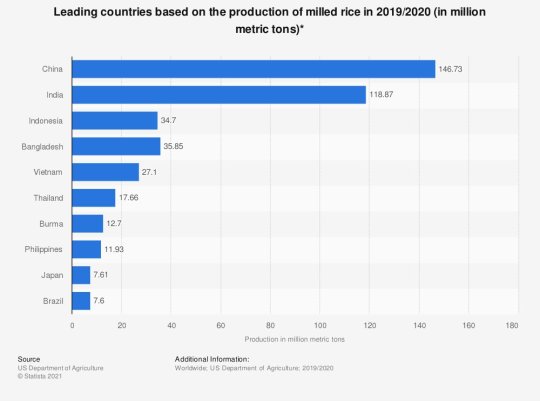
It's been 10 years since the KoS began the world tour:
-September 5741, Perseus completed
-January 5742, ground zero
~February, petrified for 7.5 years
-October 5750, arrive in India
-April 5751, arrive in Indonesia
-120 days for rice to grow, so it's around July/August.




It's a shame we didn't see traditional Australian dishes such as Vegemite, fairy bread, kangaroo meat…

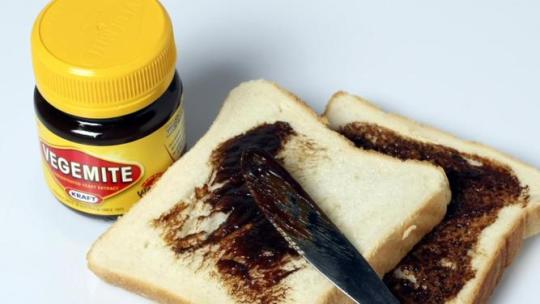

Rice grows from seed to harvest in ~120 days, so Indonesia can have 3 growing seasons. The most important one is the wet season from October to December, which is harvested in March & April. This is ~45% of total rice production for the year, which is the one the KoS harvested.

Character development.
(Gen finally tied up his cloak to stop it getting wet.)

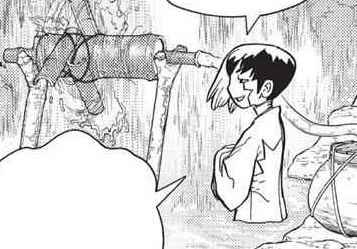

There's a lot of rice-based food in this image, so here's a few I've identified in case you need ideas for dinner.
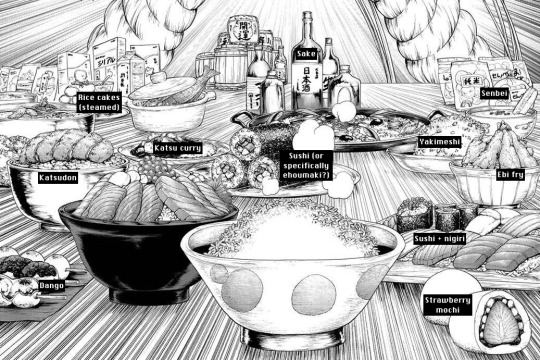
Chrome and Suika are surveying the land, presumably plotting (rice) paddies. Chrome is using a theodolite, which is used to measure angles on the horizon. Suika is probably measuring distance with the rope as extra data for their calculations.


Sai's lesson seems to be proving Heron's formula using Pythagoras' theorem.
We can also see that Chrome's handwriting has improved since the last time he had to calculate the properties of triangles!


The device Kaseki built is an Archimedes' screw, which can be used to lift liquids or sand-like mediums upwards onto higher levels. In this case, it's being used to fill the rice paddies.
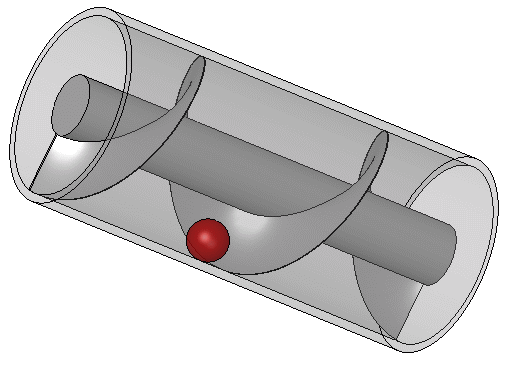
The mobile lab is truly one of the most valuable and hardworking members of the Kingdom of Science.


Nauru is one of the three great phosphorite islands in the Pacific Ocean, though thanks to too much mining in the last hundred years, the resource is almost completely depleted.
The prevalence of phosphorite is due to the albatross droppings, as Ukyo said.


When Yo said they took a pit stop, this is likely the route they took.

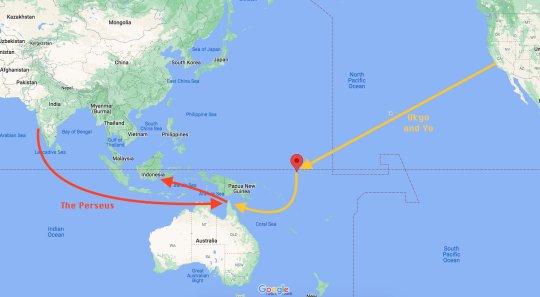
Fertilizer has 3 primary nutrients that help most plants to grow:
-Nitrogen, from the nitric acid
-Phosphorus, from the phosphorite
-Potassium, from the wood ash (this also has calcium carbonate, which, as we all know, has at least 4 uses.)

Rice has many different variants such as Japonica ("from Japan") and Indica ("from India"). Indica rice tends to be thinner and longer, and includes basmati and jasmine.
Amylopectin is a component of starch, and is what allows rice to stick to itself (necessary to make onigiri).

12 notes
·
View notes
Text

Hi, before I explain my post, I want to say something important.
• What you see my blog has become a major overhaul. And despite the changes, I decided that my 2nd account will be now my artwork blog with a secret twist.
⚠️NEW RULE! (W/ BIGGER TEXT!)⚠️
⚠️ SO PLEASE DO NOT SHARE MY 2nd ACCOUNT TO EVERYONE! THIS SECRECY BLOG OF MINE IS FOR CLOSES FRIENDS ONLY!⚠️
• AND FOR MY CLOSES FRIENDS, DON’T REBLOG IT. INSTEAD, JUST COPY MY LINK AND PASTE IT ON YOUR TUMBLR POST! JUST BE SURE THE IMAGE WILL BE REMOVED AND THE ONLY LEFT WAS THE TEXT.
⚠️ SHARING LINKS, LIKE POSTS, REBLOG POSTS, STEALING MY SNAPSHOT PHOTOS/RECORDED VIDEOS/ARTWORKS (a.k.a. ART THIEVES) OR PLAGIARIZING FROM UNKNOWN TUMBLR STRANGERS WILL IMMEDIATELY BE BLOCKED, RIGHT AWAY!⚠️
😡 WHATEVER YOU DO, DO NOT EVER LIKED & REBLOG MY SECRET POST! THIS IS FOR MY SECRET FRIENDS ONLY, NOT YOU! 😡

Okay? Capiche? Make sense? Good, now back to the post…↓
#OnThisDay: Sept 18th, 2019
Title: WMMT5DX+ to WMMT6 Changes w/ Riya's TRUE IMPREZA
IMPORTANT NOTE: I haven't posted my recent Wangan Maxi Tune experience, this month. So maybe, I could post at least once before doing some art stuff? Who knows? 🤔🤷♀️ Anyways, let's head over to my throwback...
The changes between 5DX+ and the No. 6 installment weren't as thin as before. 🤏 While the gameplay and graphics haven't changed since WMMT4 (well, kind of...?), the features from transferring data from 5DX+ to WMMT6 were a bit of a mixed bag. 😕 Like the "Extreme" VS Player mode was gone (which is an excitement challenge), and other body parts were removed, like "Body Stickers." The latter was my main concern for my 350Z and the Speedster's Impreza cars (GDB-C & GDB-F). Take Riya's Impreza Car [GBD-F].
• ABOVE PHOTO 🖼️📲: (Jan. 12,2019 at World Of Fun Arcade, SM Megamall) Here could you see her car itself was a custom body from "Racing Stripe 2" with pink color, GT Wing (3D) 1, Aero Parts C, Enkei Racing WRX TARMAC EVO Limited Edition FORGED Wheels, and FRP Bonnet A. All of them are equipped on her except her color because I need to unlock the "Light Blue" color (which is her color choice) by playing it many times.
• BELOW PHOTO 🖼️📲: Six months later, the WMMT6 was finally in the Philippines, and here's how her car was without all of the customs bodies except the Aero Parts - I picked the letter "H" for a different look. So why all of her custom bodies are wiped out except the entire Aero Parts are completely unlocked? Well because BNA (Bandai Namco Amusement) had a plan to return the level-up unlock body parts (after you beat a ghost car opponent(s)) which I've seen before in WMMT3DX+ among with predecessors, seems that in exchange for wiping off all custom cars to newly features like upgrade to 840HP when I finished the 100 episodes of "Story Mode" (that's also returned from previous Wangan Maxi installments), replacing RUF cars to Porsche brand, purchased a fully tuned ticket/ Mazda MX-5 RF RS [NDERC]/ Nissan Leopard with my Maxi Points, an improved "Online Ghost VS Battle" etc... So tbh and my opinion, well bit disappointing but very understandable so I respect that.
To this day, the developers of Wangan Maxi Tune are ongoing with updates and changes for both 6RR and 6RR+. And the latter installment has yet to be proven if it shipped to Southeast Asia 🇵🇭🇸🇬🇲🇾🇮🇩🇧🇳🇻🇳🇹🇭, and selected regions like Australia 🇦🇺, New Zealand 🇳🇿, and India 🇮🇳. North America 🇺🇸, on the other hand, still had the old (yet vanilla) 5DX+ installment... 😐😑
Riya 🐰🏎️ [wearing Teenager Hoppy and Teenager CatNap's clothes combined]: *Sigh* Yeah, and I bet we won't see our signature "Twin Stripes" sticker body, anytime soon. 😥 Even the launching 6RR+ installment to us, it won't happened. Curse you, BNA! 😐😑
BTW: If you haven't seen my recent Wangan Maxi Tune experience, then pls click here → [CLICK ME! #1], [CLICK ME! #2].
Edited & Photography by ME!
Wangan Midnight Maximum Tune series (Wangan Midnight) © Bandai Namco Amusement, Inc.; © Michiharu Kusunoki/Kodansha Ltd.
2 notes
·
View notes